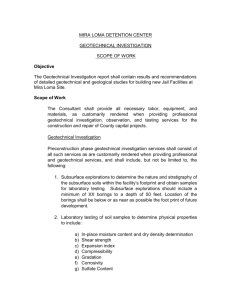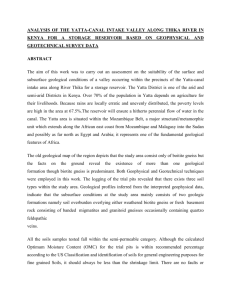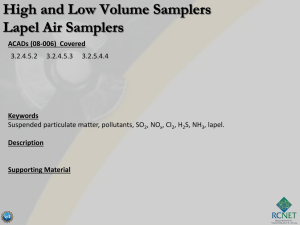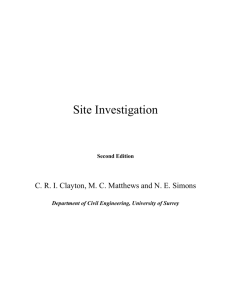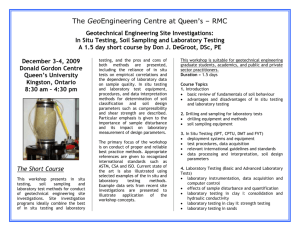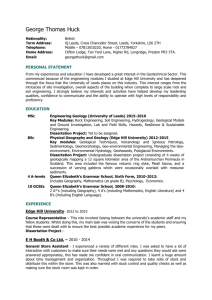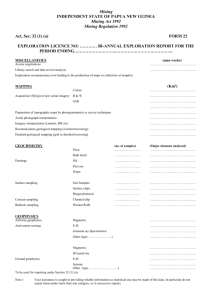Specifiying Site Investigation
advertisement
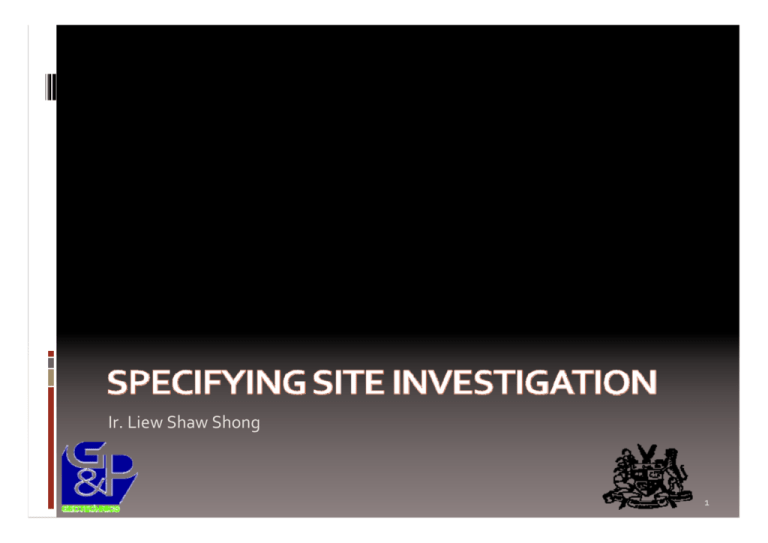
Ir. Liew Shaw Shong 1 Introduction Scope Site Investigation à Information on Hydrology, Meteorology, Environment, Natural Resources, Activities & Topography Ground Investigation à Information on Ground & Groundwater conditions Monitoring à Time dependent changes in ground movements, groundwater fluctuation & movements 2 Introduction Purpose 3 Introduction 4 Why doing GI? Why Geotechnical Engineer? What Risk & Consequence Why doing GI? It is regard as necessary, but not a rewarding expense. (Uncertainty, sufficiently accurate design options for Cost & Benefit study) Why Geotechnical Engineer? Geotechnical engineer as an underwriter for risk assessment. What Risk in Ground & its Consequence ? Ground Variability & Geo‐hazards. Financial Viability & Cost Overrun (Construction & Operation). 5 Source :http://www.sptimes.com/2004/04/16/Tampabay/At_site_of_collapse__.shtml 6 7 Source :National Geographic (Jan 2008) 8 Source :National Geographic (Jan 2008) 9 10 Geology Rock Mechanics Soil Mechanics Fracture Mechanics Hydrology Structural Mechanics Continuum Mechanics Numerical Analysis Fluid Control Systems e.g. dams Underground Structural Support Systems Geo‐structures e.g. foundations e.g. tunnel Geotechnical Engineering Surface Geo‐structures e.g. embankments, landfills Ground Improvement e.g. densification, remediation Public Policy Contract Law Risk Management Mechanical Engineering Geochemistry Construction MaterialsSite Exploration Ground Movements Modified from Morgenstern (2000) 11 Rock Mechanics Geology deformation Soil Mechanics composition failure deformation Hydrology Fracture genesis seepage failure Surface fluid flow processes Mechanics seepage blasting hydrology Structural Mechanics quarry deformation Public Policy Fluid Control Systems failure codes e.g. dams member design standard Underground Structural Support laws & compliance Continuum Mechanics Systems Geo‐structures elasticity e.g. foundations e.g. tunnel Contract Law plasticity specification idealisation Risk Management Numerical Analysis observation method boundary element risk assessment finite difference Surface Geo‐structures Ground Improvement instrumentation discrete element e.g. embankments, landfills e.g. densification, Mechanical Engineering finite element remediation drilling instrument Geochemistry excavation waste Ground Site Exploration Construction Materials leachates Movements reconnaissance practice types durability earthquake drilling experience properties liquefaction in‐situ testing geosynthetics sinkhole laboratory testing geophysics Geotechnical Engineering Modified from Morgenstern (2000) 12 Burland’s Geotechnical Triangle Genesis/Geology Morgenstern (2000) Ground Profile Site investigation Ground description Precedent, Empiricism, Experience, Risk‐management Ground Behaviour Lab/field testing Observation/measurement Appropriate Model Idealisation followed by evaluation. Conceptual or physical modelling Analytical modelling 13 How GI cost Captain, no worry! We are still far from it. Consequence Perceived Cost Actual Cost 14 How GI shall be done ? 15 16 Codes & Standards 17 Process Diagram of Ground Investigation 18 Process Diagram of Ground Investigation 19 Stage 1 of GI Desk Study Site Walk‐over Survey Identify Project Need Scope of GI Bid Document & Tender “Without Site Investigation, Ground is a Hazard” 20 Stage 2 of GI Field Supervision Sampling, In‐situ Testing, Geophysical Survey Monitoring Laboratory Testing Work Certification “Without Site Investigation, Ground is a Hazard” 21 Stage 3 of GI Factual Data Compilation Interpretation Report Preparation “Without Site Investigation, Ground is a Hazard” 22 Desk Study Information for Desk Study : • Topographic Maps • Geological Maps & Memoirs • Site Histories & Land Use • Aerial Photographs • Details of Adjacent Structures & Foundation • Adjacent & Nearby Ground Investigation Granite Alluvium Pipelines Jurong Formation Project Site 1986 Pipelines Project Site 1999 Project Site Pipeline s Project Site 23 Site Walkover Survey • Confirm the findings from Desk Study • Identify additional features & information not captured by Desk Study 24 GI Planning 25 Depth of Investigation Foundation Design Stability Analysis 26 Common Problems Incomplete Survey Information 27 GI Planning 28 GI Planning 29 Specification Objectives (study, design, forensic, construction) Type of investigation, mapping & field survey Vertical & lateral extent (termination depth) Sampling requirements (types, sampling locations & techniques) In‐situ and laboratory testing requirements (standards) Measurement/monitoring requirements (instrument types & frequency) Skill level requirements in specialist works & interpretation Report format & data presentation 30 Specification Work schedule & GI resources planning Payments for services, liability, indemnity, insurance cover 31 Boring/Drilling Recover Sample In‐situ Testing ‐ Subsurface stratification/profile ‐ Material classification & variability ‐ Laboratory tests ‐ Allow in‐situ tests down hole (profiling) ‐ Direct measurement of ground behaviours ‐ Allow monitoring instruments installed down hole Monitoring 32 Direct Method – Boring, Sampling, In‐situ & Laboratory Testing Medical Applications ‐ Biopsy sampling Geotechnical Applications ‐ Boring, Trial Pitting & Sampling • • • Thin‐walled, Piston Sampler Mazier Sampler Block Sample ‐In‐situ Testing • • • SPT, MP, CPTu, VST, PMT, DMT, PLT, Permeability Test Field Density Test ‐Laboratory Testing • • • • • • • Classification Test Compressibility Test (Oedometer/Swell) Strength Test (UU/UCT/CIU/DS) Permeability Test Compaction Test Chemical Test (pH, Cl, SO4, Organic Content, Redox, etc) Petrography & XRD 33 Indirect Method – Geophysical Survey Medical Applications ‐ X‐ray, Computer Tomography & MRI ‐ Ultra‐sound Geotechnical Applications Geophysical Survey ‐ Electromagnetic Waves (Permeability, Conductivity & Permittivity) ‐ Mechanical Wave (Attenuation, S‐waves & P‐waves) • • • • • Resistivity Method Microgravity Method Transient Electro‐Magnetic Method Ground Penetration Radar Seismic Method Santamarina, J. C. (2008) ‐ http://www.elitepco.com.tw/ISC3/images/Keynote‐03‐Santamarina.pdf 34 Geophysical Survey • Merits • Lateral variability (probing location) • Profiling (sampling & testing) • Sectioning (void detection) • Material classification • Engineering parameters (G0 & Gdynamic) • Problems •Over sale/expectation •Misunderstanding between engineers, engineering geologists & geophysicists •Lack of communication •Wrong geophysical technique used •Interference/noise 35 Sampler Split Spoon Thin‐Walled Piston Sampler Mazier Sampler Core Barrel Wire‐line 36 Sampler Split Spoon Thin‐Walled Piston Sampler Mazier Sampler Core Barrel Wire‐line 37 Sampler Split Spoon Thin‐Walled Piston Sampler Mazier Sampler Core Barrel Wire‐line 38 Sampler Split Spoon Thin‐Walled Piston Sampler Mazier Sampler Core Barrel Wire‐line 39 Sampler Split Spoon Thin‐Walled Piston Sampler Mazier Sampler Core Barrel Wire‐line 40 Sampler Split Spoon Thin‐Walled Piston Sampler Mazier Sampler Core Barrel Wire‐line 41 Sample Storage, Handling, Transportation 42 Sample Preparation 43 Sampling • Sample Sizes • Representative mass Before During After Stress relief Stress relief Stress relief Swelling Remoulding Moisture migration Compaction Displacement Extrusion Displacement Shattering Moisture loss Base heave Stone at cutting shoe Heating • Moisture content & void Piping Mixing or segregation Vibration • Chemical characteristics Caving Poor recovery Contamination (particle sizes, fabric, fissures, joints) • Adequate quantity for testing • Sample Disturbance • Stress conditions • Deformation behaviours Clayton et al (1982) 44 Sample Disturbance Poor recovery à à à Longer rest period for sample swelling Slight over‐sampling Use of sample retainer Sample contamination 45 Sample Quality Classification Sample Quality Soil Properties Classification Moisture Content Density Strength Deformation Consolidation Class 1 9 9 9 9 9 9 Class 2 9 9 9 2 2 2 Class 3 9 9 2 2 2 2 Class 4 9 2 2 2 2 2 Class 5 2 2 2 2 2 2 BS 5930 (1981) 46 In‐situ Tests Piezocone (CPTu) 47 In‐Situ Tests • BS1377 : Part 9 • Suitable for materials with difficulty in sampling • Very soft & sensitive clay • Sandy & Gravelly soils • Weak & Fissured soils • Fractured rocks • Interpretation • Empirical • Semi‐empirical • Analytical 48 Applicability of In‐situ Tests Test Stress Strength Permeability Stiffness φ’ Cu σc E’/G Eu Gmax SPT G C R G C G CPT/CPTu G C K0 DMT G, C G G Borehole PMT C G, R C PLT C G, R C VST C Seismic SBPMT k G, C, R G, C G C G, C Falling/ Rising Head Test G Constant Head Test C Packer Test Clayton , et al (1995) G = granular, C = cohesive, R = Rock R 49 Applicability of In‐situ Tests 50 In‐situ Tests 51 In‐situ Tests Pressuremeter (PMT) 52 In‐situ Tests Dilatometer (DMT) 53 Instrumentation Monitoring • Inclinometer • Extensometer Toward River • Rod Settlement Gauge/Marker • Piezometer • Observation Well 54 Laboratory Tests 55 Source : Life Style Magazine ‐ EDGE 56 Ground Characterisation Focus of Geological Model Stratification Historical Geological Processes Geological Structures Weathering Hydrogeology Geo‐ morphology 57 Geological Mapping Mapping of : ‐ Geological features (Structural ‐ Geomorphology settings) ‐ Lithology ‐ Weathering profile ‐ Stratification ‐ Outcrop exposure ‐ Seepage conditions 58 Ground Characterisation Focus of Geotechnical Model Subsurface Profile Strength Material Type Stiffness Permeability Chemical Characteristics 59 60 61 General Dilemma of GI Industry • Lack of pride & appreciation from consultant/client in GI industry. • Actions done is considered work done! Poor professionalism. Financial survival problem due to competitive rates in uncontrolled environment (cutting corner) No appropriate time frame for proper work procedures (shoddy works) Shifting of skilled expert to Oil & Gas or other attractive industries 62 Poor Planning & Interpretation Inadequate investigation coverage vertically & horizontally Wrong investigating tools No/wrong interpretation Poor investigating sequence 63 Poor Site Implementation Lack of level & coordinates of probing location Sample storage, handling, transportation Inappropriate equilibrium state in Observation Well & Piezometer 64 Poor In‐situ & Laboratory Results Lack of calibration Equipment calibration Wear & Tear Errors Equipment systematic error (rod friction, electronic signal drift, unsaturated porous tip) Defective sensor Inappropriate testing procedures (Variation of pH Values) Improper sample preparation Inadequate saturation Inappropriate testing rate Inadequate QA/QC in testing processes Inherent sample disturbance before testing 65 Poorly Maintained Tools 66 Over‐confidence in Geophysics ‐ We detect everything in geophysical data, but indentify almost nothing (Rich but Complex). ‐Not a unique solution in tomographic reconstruction (Indirect method) ‐ Poor remuneration to land geophysicist as compared to O&G ‐ Poor investigation specification ‐ Lack of good interpretative skill (human capital) ‐ High capital costs in equipment & software investment 67 Communication Problem We are connecting the bridge deck at the same level successfully! 68 Difficulties in Identification of Complex Geological Settings 69 Difficulties in Identification of Complex Geological Settings 70 Weathering Profile Deviation of material classification between borehole and excavation (Claim issue – Soil or Rock ?) 71 Complexity of Rock Mass Properties Complicated rock mass strength ( slope & excavation design) Requiring judgement (involving subjectivity) Information normally only available during construction ⎡ ⎛ σ 3' ⎞ ⎤ ⎟ + s⎥ σ 1 ' = σ 3 ' + σ u ⎢mb ⎜ ⎢⎣ ⎜⎝ σ u ⎟⎠ ⎥⎦ 72 a Unexpected Blowout of Underground Gas Gas pockets at 32m bgl Flushing out of sand 73 Supervision Work compliance & certification Document critical information Timely on‐course instruction (sampling, in‐ situ testing & termination) Checking between field records and reported information 74 Future Trend ‐ Electronic Data Collection, Transfer & Management • AGS data transfer format & AGS‐M format (monitoring data) • First Edition in 1992, AGS(1992) • Second Edition in 1994, AGS(1994) • Third Edition in 1999 • Advantages : • Efficient & Simplicity • Minimised human error • GI & Monitoring Data Management System • Record keeping • Spatial data analysis http://www.ags.org.uk/site/datatransfer/intro.cfm 75 Conclusions Nature of GI works & Geotechnical design (Uncertainties) Role of Geotechnical Engineer, Engineering Geologist & Geophysicist Stages of GI works (Planning, Implementation, Interpretation & Report) Specifications Methodology of GI (Merits & Demerits) à Fieldworks (Direct/Indirect) + Geological Mapping à Laboratory tests Common Problems & Future Trend 76 References Anon (1999). “Definition of Geotechnical Engineering”. Ground Engineering, Vol. 32, No. 11, pp. 39. BSI (1981). “Code of Practice for Site Investigation, BS 5930”. British Standards Institution, London. BSI (1981). “Code of Practice for Earthworks, BS 6031”. British Standards Institution, London. BSI (1986). “Code Practice for Foundation, BS8004”. British Standards Institution, London. BSI (1990). “British Standard Methods of Test for Soils for Civil Engineering Purposes, BS 1377”. British Standards Institution, London. Clayton, C. R. I., Matthews, M. C. & Simons, N. E. (1995). “Site Investigation”, Blackwell Science, 2nd edition. Gue, S. S. & Tan, Y. C. (2005), “Planning of Subsurface Investigation and Interpretation of Test Results for Geotechnical Design”, Sabah Branch, IEM. Liew, S. S. (2005). “Common Problems of Site Investigation Works in a Linear Infrastructure Project”, IEM‐MSIA Seminar on Site Investigation Practice, 9 August 2005, Armada Hotel, Kuala Lumpur. European Group Subcommittee (1968). “Recommended method of Static and Dynamic Penetration Tests 1965”. Geotechnique, Vol. 1, No. 1. 77 References FHWA (2002), “Subsurface Investigations — Geotechnical Site Characterization”. NHI Course No. 132031. Publication No. FHWA NHI‐01‐031 GCO (1984). “Geotechnical Manual for Slopes”. Geotechnical Control Office, Hong Kong GCO (1980). “Geoguide 2 : Guide to Site Investigation, Geotechnical Control Office, Hong Kong Gue, S. S. (1985). “Geotechnical Assessment for Hillside Development”. Proceedings of the Symposium on Hillside Development; Engineering Practice and Local By‐Laws, The Institution of Engineers, Malaysia. Head, K. H. (1984). “Manual of Soil Laboratory testing”. Morgenstern, N. R. (2000). “Common Ground”. GeoEng2000, Vol. 1, pp. 1‐20. Neoh, C. A. (1995). “Guidelines for Planning Scope of Site Investigation for Road Projects”. Public Works Department, Malaysia Ooi, T.A. & Ting, W.H. (1975). “The Use of a Light Dynamic Cone Penetrometer in Malaysia”. Proceeding of 4th Southeast Asian Conference on Soil Engineering, Kuala Lumpur, pp. 3‐62, 3‐79 Ting, W.H. (1972). “Subsurface Exploration and Foundation Problems in the Kuala Lumpur Area”. Journal of Institution of Engineers, Malaysia, Vol. 13, pp. 19‐25 Santamarina, J. C. (2008). “The Geophysical Properties of Soils”, 3rd Int. Conf. on Site Characterisation, Keynote Lecture No. 3, Taiwan. Site Investigation Steering Group, “Without Site Investigation, Ground is a Hazard”, Part 1, Site Investigation in Construction, Thomas Telford Ltd. 78 79
